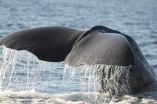(Press-News.org) The combined heat from climate change and urbanization is likely to reduce the number of eastern swallowtails and other native butterflies in Ohio and promote the spread of invasive relatives, a new study led by a Case Western Reserve University researcher shows.
Among 20 species monitored by the Ohio Lepidopterists society, eight showed significant delays in important early lifecycle events when the two factors were combined—a surprising response that may render the eight unfit for parts of the state where they now thrive.
Butterflies serve as important indicator species for how the broader ecosystem might be impacted, the researchers say. They are pursuing further studies to learn whether the negative impacts on multiple species add up to cause disruptions to the environment.
Other studies have shown that butterflies respond to higher temperatures due either to climate change or turning farmland and forests into asphalt and concrete by first appearing—and reaching peak numbers—earlier in the year.
"But when you combine the effects, it sort of throws a wrench in how you predict species' responses," said Sarah Diamond, an assistant professor of biology at Case Western Reserve and lead author of the study, now online in the journal Ecology at http://www.esajournals.org/doi/abs/10.1890/13-1848.1.
The findings, the researchers say, may be useful to predict effects of environmental changes over the next decades and develop strategies to respond, and can likely be applied worldwide
Diamond worked with Heather Cayton, Tyson Wepprich, Clinton Jenkins, Rob Dunn and Nick Haddad of the department of biological sciences at North Carolina State University; and Leslie Ries, of the biology department at the University of Maryland.
The study
Researchers analyzed 13 years of butterfly monitoring records by lepidopterists society volunteers at 83 locations statewide. The monitoring sites include locations in parks and preserves throughout Ohio.
Nearly 230 Society monitors recorded species numbers from the first week of April through the first week of November. Their data was compared with temperature records.
Temperatures were taken from the nearest National Oceanic and Atmospheric Administration meteorological stations, which avoid the warming effects of urbanization.
Sites in southern Ohio ranged 2 to 3 degrees Celsius warmer than northern sites on a given day. That difference reflects the amount of warming climate change models predict for the Midwest later this century, enabling the researchers to see how the change may alter butterfly lifecycles.
The lepidopterists' records showed that butterflies generally emerged up to three weeks earlier and reached peak numbers sooner in southern Ohio than mid- and northern Ohio.
Biologists believe that advancing their lifecycle events a couple of weeks enables butterflies to take advantage of earlier flowering induced by warmer temperatures. The bigger payoff is a species may add another generation in a year, increasing its population and ability to compete.
Urban heat tips pattern
To estimate the heat from urbanization, researchers calculated the percent of impervious surface within 1 kilometer of each monitoring site, using the National Land Cover Database. Research by others shows the percentage of impervious surface is correlated with specific increases in surface and air temperatures.
When this heat was added to the already warmer temperatures in greater Cincinnati and Dayton, seven species delayed their initial appearances. Three of them, plus one other species, delayed their peak numbers.
"Butterflies need warmth from the environment to develop," Ries said. "As their environment gets warmer, they have more and more energy but at extremes, it's too hot and they die.
"Before it becomes lethal, too much heat can slow growth," she said. "That's why we see the delay."
The delays may leave a species with fewer resources to feed and lay eggs or may expose them to great risk of predation, resulting in a smaller next generation, the scientists said. Such a scenario may lead to loss of local populations.
The eastern tiger swallowtail, pearl crescent and red admiral, all noted for their beauty, are among the eight species that delay and are more likely to suffer in the future in Ohio.
Invasives, such as the cabbage white and European skipper, are more likely to thrive. These species are called "weedy," meaning they can feed and lay eggs on a wide variety of plants. They were largely unaffected by the combined heat.
The researchers studied Ohio butterflies after Ries found the state has the most intensive monitoring records in the United States. While many other states are doing monitoring, most volunteers only go out about 7 times a year, Ohio volunteers go out 15 to 30 times per year. "That really helps us track shifts in timing, something that is more difficult to do with less intensive protocols" Ries said.
"If our data can be used for some enlightenment, we're happy to have it used," said Jerry Weidman, who chairs the society committee in charge of monitoring.
Volunteers generate the records. They choose a section of trail and record the species and numbers they see within 7.5 feet of either side, Weidman explained. They monitor weekly from the beginning to end of the main butterfly flight season
"One lab could never do something of this scope," Diamond said. "Citizen scientists can help us do things on a scale never thought possible."
The researchers believe their findings are applicable nationally and globally. Patterns of temperatures varying by geography, and over time under climate change, coupled with gradients of rural to urban habitats, are widespread.
Diamond and colleagues are now setting up growth chambers to study butterfly physiology in the lab. They will simulate environmental conditions, including climate change and urbanization to see what temperatures or other factors trigger changes in growth and behavior, and when. From that, they hope to develop predictions to help conserve each species.
INFORMATION:
Some Ohio butterflies threatened by rising temperatures
Heat of climate change, roads and buildings likely to harm several species
2014-05-01
ELSE PRESS RELEASES FROM THIS DATE:
Whales hear us more than we realize
2014-05-01
RICHLAND, Wash. – Killer whales and other marine mammals likely hear sonar signals more than we've known.
That's because commercially available sonar systems, which are designed to create signals beyond the range of hearing of such animals, also emit signals known to be within their hearing range, scientists have discovered.
The sound is likely very soft and audible only when the animals are within a few hundred meters of the source, say the authors of a new study. The signals would not cause any actual tissue damage, but it's possible that they affect the behavior ...
Penn Vet research identifies compounds that control hemorrhagic viruses
2014-05-01
People fear diseases such as Ebola, Marburg, Lassa fever, rabies and HIV for good reason; they have high mortality rates and few, if any, possible treatments. As many as 90 percent of people who contract Ebola, for instance, die of the disease.
Facing this gaping need for therapies, researchers at the University of Pennsylvania School of Veterinary Medicine teamed with colleagues to focus on identifying and developing compounds that could reduce a virus' ability to spread infection. In two studies published in the Journal of Virology, the researchers have identified several ...
Hubble astronomers check the prescription of a cosmic lens
2014-05-01
Two teams of astronomers using the NASA/ESA Hubble Space Telescope have discovered three distant exploding stars that have been magnified by the immense gravity of foreground galaxy clusters, which act like "cosmic lenses". These supernovae are the first of their type ever to be observed magnified in this way and they offer astronomers a powerful tool to check the prescription of these massive lenses.
Massive clusters of galaxies act as "gravitational lenses" because their powerful gravity bends light passing through them [1]. This lensing phenomenon makes faraway objects ...
The real difference between how men and women choose their partners
2014-05-01
This news release is available in French. In Concordia's study, men responded more strongly to the "framing effect" when physical attractiveness was described.
A hamburger that's 90 per cent fat-free sounds a lot better than one with 10 per cent fat. And even when the choices are the same, humans are hard-wired to prefer the more positive option.
This is because of what's known as the "framing effect," a principle that new research from Concordia has proved applies to mate selection, too.
The study — co-authored by Concordia marketing professor Gad Saad and Wilfrid ...
Casualties get scant attention in wartime news, with little change since World War I
2014-05-01
The human costs of America's wars have received scant attention in daily war reporting – through five major conflicts going back a century – says an extensive and first-of-its-kind study of New York Times war coverage being published this month.
It's timely research given the major anniversaries this year for three of those conflicts.
No matter the war, the number of dead and wounded, the degree of government censorship, the type of warfare, or whether volunteers or draftees are doing the fighting, casualties get little mention, says Scott Althaus, a University of Illinois ...
Can money buy happiness? For some, the answer is no
2014-05-01
SAN FRANCISCO, May 1, 2014 -- Many shoppers, whether they buy material items or life experiences, are no happier following the purchase than they were before, according to a new study from San Francisco State University.
Although previous research has shown experiences create greater happiness for buyers, the study suggests that certain material buyers -- those who tend to purchase material goods -- may be an exception to this rule. The study is detailed in an article to be published in the June edition of the Journal of Research in Personality.
"Everyone has been told ...
Scientists propose amphibian protection
2014-05-01
An ecological strategy developed by four researchers, including two from Simon Fraser University, aims to abate the grim future that the combination of two factors could inflict on many amphibians, including frogs and salamanders.
A warming climate and the introduction of non-native fish in the American West's mountainous areas are combining to threaten the habitat that this ecologically critical group of species needs to thrive.
Previous studies predict the combined effect of climate change and non-native fish could cause amphibian populations to decline and even ...
Noncombat injury top reason for pediatric care by military surgeons in Afghanistan, Iraq
2014-05-01
Chicago (May 1, 2014): Noncombat-related injury—caused by regular car accidents, falls and burns—is the most common reason for pediatric admissions to U.S. military combat hospitals in both Iraq and Afghanistan reveals new study findings published in the May issue of the Journal of the American College of Surgeons.
In recent years, research has shown that Army hospitals treat a significant number of wounded and sick children in Iraq and Afghanistan. But the new analysis explores the nature of that care, determining how many children were treated for combat-related injuries ...
Bureau of Reclamation Water Management video series highlights collaborative research
2014-05-01
WASHINGTON - The Bureau of Reclamation is releasing a series of videos summarizing collaborative research addressing climate change and variability impacts, estimating flood and drought hazards, and improving streamflow prediction. This information was presented in January at the Second Annual Progress Meeting on Reclamation Climate and Hydrology Research.
"For more than 100 years, Reclamation and its partners have developed the tools to guide a sustainable water and power future for the West," said Acting Commissioner Lowell Pimley. "This video series summarizes collaborative ...
Studies identify spinal cord neurons that control skilled limb movement
2014-05-01
NEW YORK, NY (May 1, 2014) —Researchers have identified two types of neurons that enable the spinal cord to control skilled forelimb movement. The first is a group of excitatory interneurons that are needed to make accurate and precise movements; the second is a group of inhibitory interneurons necessary for achieving smooth movement of the limbs. The findings are important steps toward understanding normal human motor function and potentially treating movement disorders that arise from injury or disease.
"We take for granted many motor behaviors, such as catching a ...
LAST 30 PRESS RELEASES:
Air pollution exposure and birth weight
Obstructive sleep apnea risk and mental health conditions among older adults
How talking slows eye movements behind the wheel
The Ceramic Society of Japan’s Oxoate Ceramics Research Association launches new international book project
Heart-brain connection: international study reveals the role of the vagus nerve in keeping the heart young
Researchers identify Rb1 as a predictive biomarker for a new therapeutic strategy in some breast cancers
Survey reveals ethical gaps slowing AI adoption in pediatric surgery
Stimulant ADHD medications work differently than thought
AI overestimates how smart people are, according to HSE economists
HSE researchers create genome-wide map of quadruplexes
Scientists boost cell "powerhouses" to burn more calories
Automatic label checking: The missing step in making reliable medical AI
Low daily alcohol intake linked to 50% heightened mouth cancer risk in India
American Meteorological Society announces Rick Spinrad as 2026 President-Elect
Biomass-based carbon capture spotlighted in newly released global climate webinar recording
Illuminating invisible nano pollutants: advanced bioimaging tracks the full journey of emerging nanoscale contaminants in living systems
How does age affect recovery from spinal cord injury?
Novel AI tool offers prognosis for patients with head and neck cancer
Fathers’ microplastic exposure tied to their children’s metabolic problems
Research validates laboratory model for studying high-grade serous ovarian cancer
SIR 2026 delivers transformative breakthroughs in minimally invasive medicine to improve patient care
Stem Cell Reports most downloaded papers of 2025 highlight the breadth and impact of stem cell research
Oxford-led study estimates NHS spends around 3% of its primary and secondary care budget on the health impacts of heat and cold in England
A researcher’s long quest leads to a smart composite breakthrough
Urban wild bees act as “microbial sensors” of city health.
New study finds where you live affects recovery after a hip fracture
Forecasting the impact of fully automated vehicle adoption on US road traffic injuries
Alcohol-related hospitalizations from 2016 to 2022
Semaglutide and hospitalizations in patients with obesity and established cardiovascular disease
Researchers ‘listen in’ to embryo-mother interactions during implantation using a culture system replicating the womb lining
[Press-News.org] Some Ohio butterflies threatened by rising temperaturesHeat of climate change, roads and buildings likely to harm several species




